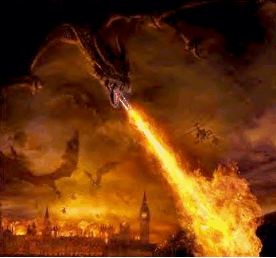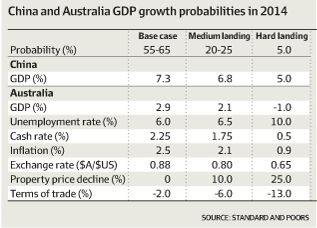
From the AFR comes some interesting prognosticating from Standard & Poors’ (S&P) analyst, Craig Michaels, on the risks posed from a sharper than expected slowdown of the Chinese economy.
Michaels notes that “renewed uncertainty surrounding China’s economic outlook is casting a long shadow over Australia’s own economic prospects” and questions whether we are “now seeing the beginning of the end of Australia’s economic run?”. He provides three slowdown scenarios for 2014 and their forecast impact on the Australian economy and house prices. These are outlined in the below table:

In the “baseline scenario” (55% to 65% probability), Chinese growth slows marginally to 7.3% (from 7.5% in the year to June 2013). The impact on Australia is minimal, with GDP rising to 2.9% annually (from 2.5% currently), unemployment rising slightly to 6.0%, the cash rate falling by 0.25% to 2.25%, the exchange rate falling slightly to $US0.88, the terms-of-trade falling by only 2%, and house price growth flatlining.
Under the “medium landing” scenario (20% to 25% probability), Chinese growth slows marginally to 6.8%. The impact on Australia is more significant, with GDP falling to 2.1% annually (from 2.5% currently), unemployment rising slightly to 6.5%, the cash rate falling by 0.75% to 1.75%, the exchange rate falling to $US0.80, the terms-of-trade falling by 6%, and house prices falling by 10%.
Finally, under the highly unlikely “hard landing” scenario (5% probability), Chinese growth tanks to 5.0%, which causes Australian GDP to contract by 1.0%, unemployment to surge to 10%, the cash rate to fall to only 0.5%, the exchange rate to dive to $US0.65, the terms-of-trade to decline by 13%, and house prices to tank by 25%.
Some of Michaels’ figures look a bit odd, given Australia’s current positioning. For example, I expect the terms-of-trade to decline by more than forecast under each scenario. The GDP forecasts also look a bit bullish given mining-related capital expenditures will likely detract significantly from growth next year.
The 5% probability of of a Chinese hard landing in 2014 is probably fair enough. That said, I think there is a much greater probability that China’s economy will experience a hard landing at some point in the medium-term, which would have a significant impact on the Australian economy, although the timing is obviously unknown.
The house price forecasts look reasonable if we assume that prices continue to accelerate until the end of 2013, leaving less scope for growth in 2014 and heightening downside risks if the Chinese economy hits a snag.

